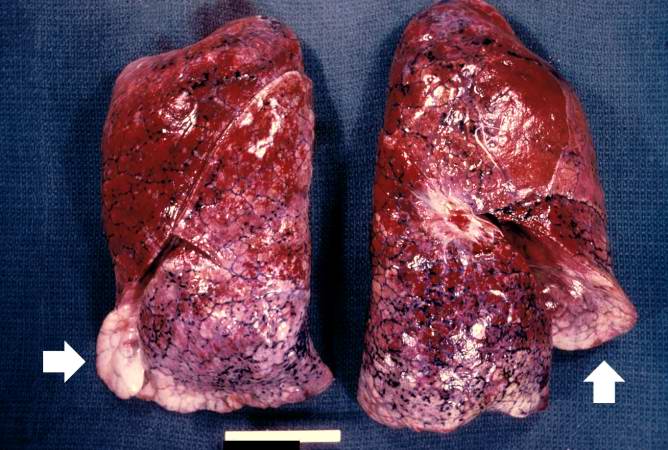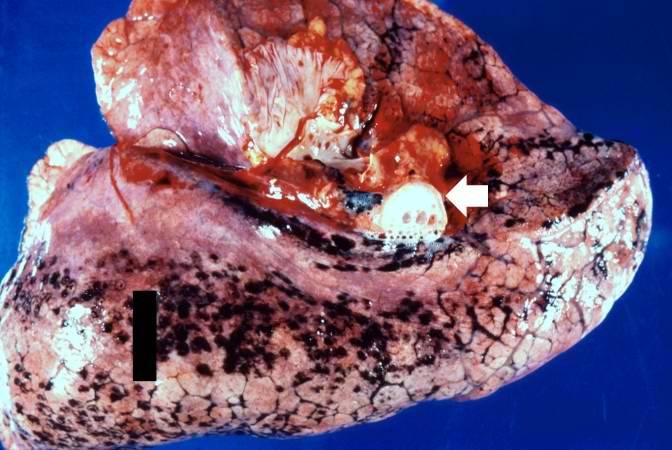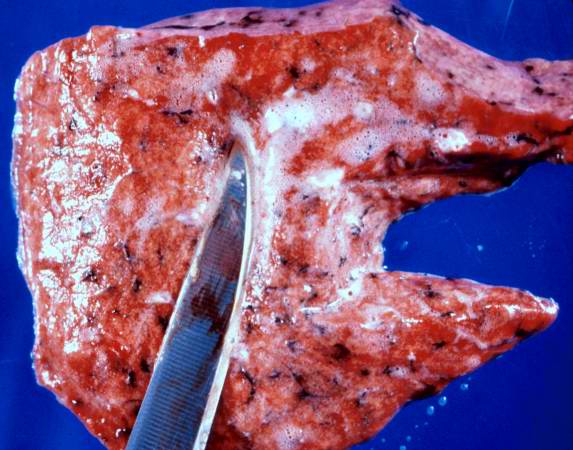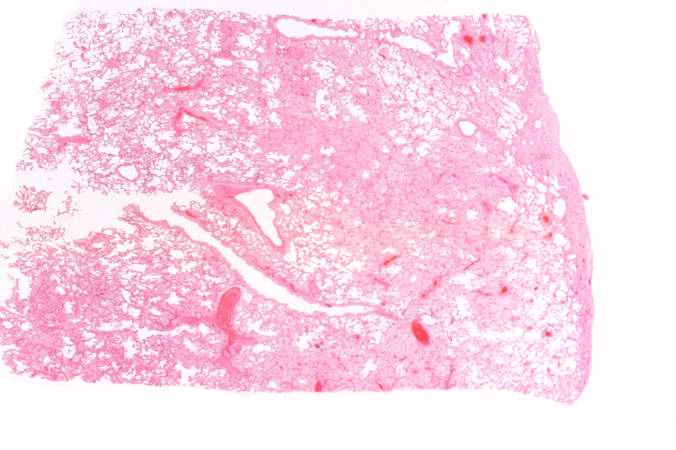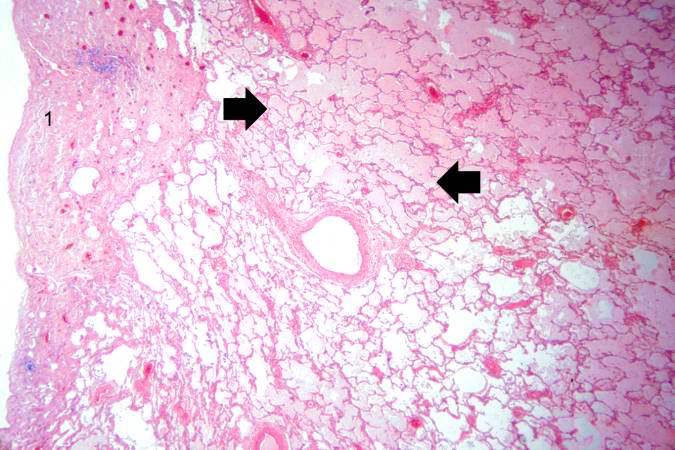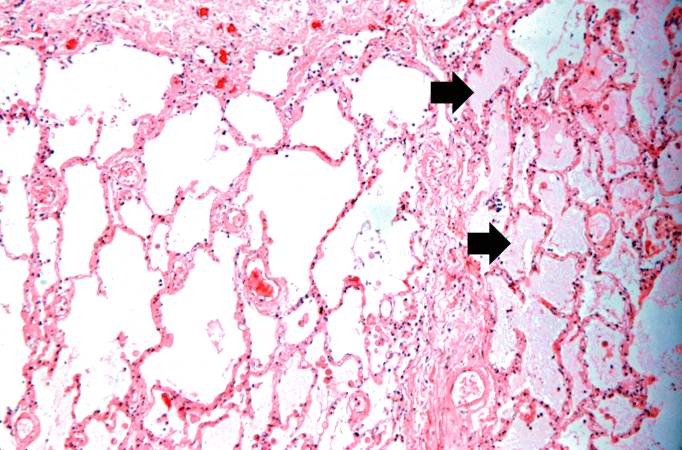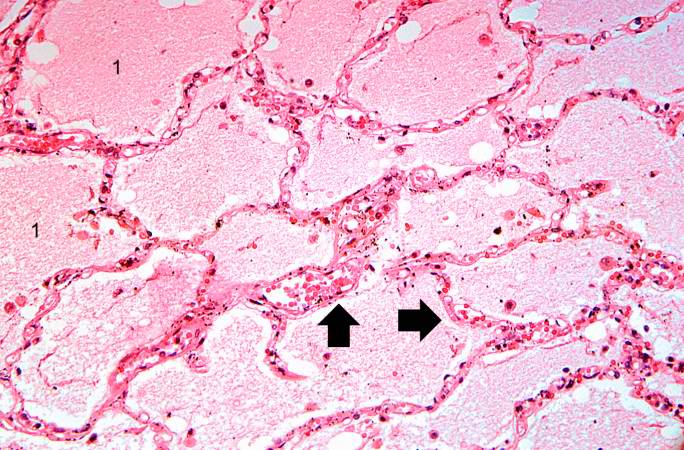Pulmonary edema
| Pulmonary edema | |
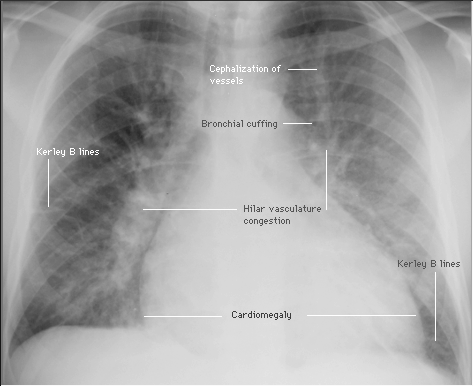 | |
|---|---|
| Chest x-ray showing pulmonary edema | |
| ICD-10 | J81 |
| ICD-9 | 514 |
| DiseasesDB | 11017 |
| MedlinePlus | 000140 |
| eMedicine | med/1955 radio/581 |
|
WikiDoc Resources for Pulmonary edema |
|
Articles |
|---|
|
Most recent articles on Pulmonary edema Most cited articles on Pulmonary edema |
|
Media |
|
Powerpoint slides on Pulmonary edema |
|
Evidence Based Medicine |
|
Clinical Trials |
|
Ongoing Trials on Pulmonary edema at Clinical Trials.gov Trial results on Pulmonary edema Clinical Trials on Pulmonary edema at Google
|
|
Guidelines / Policies / Govt |
|
US National Guidelines Clearinghouse on Pulmonary edema NICE Guidance on Pulmonary edema
|
|
Books |
|
News |
|
Commentary |
|
Definitions |
|
Patient Resources / Community |
|
Patient resources on Pulmonary edema Discussion groups on Pulmonary edema Patient Handouts on Pulmonary edema Directions to Hospitals Treating Pulmonary edema Risk calculators and risk factors for Pulmonary edema
|
|
Healthcare Provider Resources |
|
Causes & Risk Factors for Pulmonary edema |
|
Continuing Medical Education (CME) |
|
International |
|
|
|
Business |
|
Experimental / Informatics |
| Cardiology Network |
 Discuss Pulmonary edema further in the WikiDoc Cardiology Network |
| Adult Congenital |
|---|
| Biomarkers |
| Cardiac Rehabilitation |
| Congestive Heart Failure |
| CT Angiography |
| Echocardiography |
| Electrophysiology |
| Cardiology General |
| Genetics |
| Health Economics |
| Hypertension |
| Interventional Cardiology |
| MRI |
| Nuclear Cardiology |
| Peripheral Arterial Disease |
| Prevention |
| Public Policy |
| Pulmonary Embolism |
| Stable Angina |
| Valvular Heart Disease |
| Vascular Medicine |
Editor-In-Chief: C. Michael Gibson, M.S., M.D. [1]
Associate Editor-In-Chief: Cafer Zorkun, M.D., Ph.D. [2]
Please Take Over This Page and Apply to be Editor-In-Chief for this topic: There can be one or more than one Editor-In-Chief. You may also apply to be an Associate Editor-In-Chief of one of the subtopics below. Please mail us [3] to indicate your interest in serving either as an Editor-In-Chief of the entire topic or as an Associate Editor-In-Chief for a subtopic. Please be sure to attach your CV and or biographical sketch.
Overview
Pulmonary edema (American English) or oedema (British English) is swelling and/or fluid accumulation in the lungs. It leads to impaired gas exchange and may cause respiratory failure. It is due to either failure of the heart to remove fluid from the lung circulation ("cardiogenic pulmonary edema"), or due to a direct injury to the lung parenchyma ("noncardiogenic pulmonary edema").[1] Differential Diagnosis of Pulmonary edema
Signs and symptoms
Symptoms of pulmonary edema include difficulty breathing, coughing up blood, excessive sweating, anxiety and pale skin. A classical sign of pulmonary edema is the production of pink frothy sputum. If left untreated, it can lead to coma and even death, generally due to its main complication of hypoxia.
If pulmonary edema has been developing gradually, symptoms of fluid overload may be elicited. These include nocturia (frequent urination at night), ankle edema (swelling of the legs, generally of the "pitting" variety, where the skin is slow to return to normal when pressed upon), orthopnea (inability to lie down flat due to breathlessness) and paroxysmal nocturnal dyspnea (episodes of severe sudden breathlessness at night).
Diagnosis
Pulmonary edema is generally suspected due to findings in the medical history, such as previous cardiovascular disease, and physical examination: end-inspiratory crackles (sounds heard at the end of a deep breath) on auscultation (listening to the breathing through a stethoscope) are characteristic for pulmonary edema. The presence of a third heart sound (S3) is predictive of cardiogenic pulmonary edema.[1]
Blood tests are generally performed for electrolytes (sodium, potassium) and markers of renal function (creatinine, urea). Liver enzymes, inflammatory markers (usually C-reactive protein) and a complete blood count as well as coagulation studies (PT, aPTT) are typically requested. B-type natriuretic peptide (BNP) is available in many hospitals, especially in the US, sometimes even as a point-of-care test. Low levels of BNP (<100 pg/ml) make a cardiac cause very unlikely.[1]
The diagnosis is confirmed on X-ray of the lungs, which shows increased fluid in the alveolar walls. Kerley B lines, increased vascular filling, pleural effusions, upper lobe diversion (increased blood flow to the higher parts of the lung) may be indicative of cardiogenic pulmonary edema, while patchy alveolar infiltrates with air bronchograms are more indicative of noncardiogenic edema[1]
Low oxygen saturation and disturbed arterial blood gas readings may strengthen the diagnosis and provide grounds for various forms of treatment. If urgent echocardiography is available, this may strengthen the diagnosis, as well as identify valvular heart disease. In rare occasions, insertion of a Swan-Ganz catheter may be required to distinguish between the two main forms of pulmonary edema.[1]
Causes
Pulmonary edema is either due to direct damage to the tissue or as a result of inadequate functioning of the heart or circulatory system.
Cardiogenic
- Severe arrhythmias (tachycardia/fast heartbeat or bradycardia/slow heartbeat)
- Arteriovenous malformation
- Anomalous pulmonary venous return
- Aortic Regurgitation
- Aortic Stenosis
- Arrhythmia
- Cardiomyopathy
- Congenita pulmonary venous stenosis
- Congestive heart failure
- Coronary Heart Disease
- Hypertensive crisis
- Left Heart Failure
- Left-to-Right Shunt
- Mitral Regurgitation
- Mitral Stenosis
- Myocarditis
- Pericardial Disease. Pericardial effusion with tamponade
- ST elevation MI with left ventricular failure
Non-cardiogenic
This form is contiguous with ARDS (acute respiratory distress syndrome):
- Acute Bronchial Asthma
- Acute Renal Failure
- Bacterial toxins
- Blood Transfusions
- Burns
- Chronic mediastinitis
- Decompression sickness
- Disseminated Intravascular Coagulation
- Drowning
- Drugs
- Fibrotic/inflammatory disease
- Fluid overload, e.g. from kidney failure
- Gastric content aspiration
- Goodpasture's Syndrome
- High altitude sickness. Ascent to high altitude occasionally causes high altitude pulmonary edema (HAPE)[2]
- Hyperhydration
- Hypoalbuminemia / Albumin deficiency
- Idiopathic Venoocclusive Disease
- Inhalation of toxic gases
- Infection
- Leukemia
- Malaria
- Miliary Tuberculosis
- Neurogenic, e.g. subarachnoid hemorrhage
- Pheochromocytoma
- Pneumonia
- Pulmonary contusion, i.e. high-energy trauma
- Pulmonary Embolism
- Reexpansion, i.e. post pneumonectomy or large volume thoracentesis
- Reperfusion injury, i.e. postpulmonary thromboendartectomy or lung transplantation
- Sepsis
- Shock
- Toxic Shock Syndrome
- Multitrauma, e.g. motor vehicle accident
- Upper airway obstruction
- Uremia
Complete Differential Diagnosis of the Causes of Pulmonary Edema
(By organ system)
| Cardiovascular | |
| Chemical / poisoning | |
| Dermatologic | |
| Drug Side Effect | |
| Ear Nose Throat | |
| Endocrine | |
| Environmental | |
| Gastroenterologic | |
| Genetic | |
| Hematologic | |
| Iatrogenic | |
| Infectious Disease | |
| Musculoskeletal / Ortho | |
| Neurologic | |
| Nutritional / Metabolic | |
| Obstetric/Gynecologic | |
| Oncologic | |
| Opthalmologic | |
| Overdose / Toxicity | |
| Psychiatric | |
| Pulmonary | |
| Renal / Electrolyte | |
| Rheum / Immune / Allergy | |
| Sexual | |
| Trauma | |
| Urologic | |
| Miscellaneous |
Treatment
Depends on the cause, but focuses on maximizing respiratory function and removing the cause. When circulatory causes have led to pulmonary edema, treatment with intravenous nitrates (glyceryl trinitrate), and loop diuretics, such as furosemide or bumetanide, is the mainstay of therapy. These improve both preload and afterload, and aid in improving cardiac function.
There are no causal therapies for direct tissue damage; removal of the causes (e.g. treating an infection) is the most important measure.
Sometimes the development of pulmonary edema will be referred to as flash pulmonary edema (FPE). This referes to the rapid onset of pulmonary edema. It is most often precipitated by acute myocardial infarction or mitral regurgitation, but can be caused by aortic regurgitation, heart failure, or almost any cause of elevated left ventricular filling pressures.
Treatment of FPE should be directed at the underlying cause, but the mainstays are ensuring adequate oxygenation, diuresis, and decrease of pulmonary circulation pressures.
Reoccurrence of FPE is thought to be associated with hypertension[3] and may signify renal artery stenosis.[4] Prevention of reoccurrence is based on managing hypertension, coronary artery disease, renovascular hypertension, and heart failure.
Focus is initially on maintaining adequate oxygenation. This may happen with high-flow oxygen, noninvasive ventilation (either continuous positive airway pressure (CPAP) or variable positive airway pressure (VPAP)[5][6]) or mechanical ventilation in extreme cases.
Case Report
Clinical Summary
A 69-year-old male with well-controlled Type I diabetes mellitus (insulin-dependent) presented with upper abdominal and lower chest pain of four hours duration and accompanied by shortness of breath and diaphoresis.
An electrocardiogram revealed multiple premature ventricular contractions (PVCs).
The hospital course was characterized by recurrent pulmonary edema and oliguria.
The terminal event was cardiac arrest.
Autopsy Study
Significant findings at postmortem examination were old and recent myocardial infarctions and evidence of congestive heart failure.
The right and left lungs weighed 950 grams and 750 grams, respectively, and were reddish-brown.
Histopathological Findings
-
This is a gross photograph of lungs that are distended and red. The reddish coloration of the tissue is due to congestion. Some normal pink lung tissue is seen at the edges of the lungs (arrows).
-
This is a gross photograph of lung demonstrating acute pulmonary congestion and edema. A frothy exudate fills the bronchus (arrow).
-
This gross photograph demonstrates the frothy exudate that is being extruded from the lung tissue.
-
This is a low-power photomicrograph of lung from this case. The lung section has a pale-red color indicating proteinaceous material within the lung.
-
This is a higher-power photomicrograph of lung. The edema fluid within the alveoli is visible at this higher magnification (arrows). The thickened pleura (1) is on the left.
-
This is a higher-power photomicrograph showing edema-filled alveoli in the right portion of this section (arrows).
-
This high-power photomicrograph illustrates the edema fluid within the alveoli (1) and the congestion (RBCs) in the alveolar capillaries (arrows).
References
- ↑ 1.0 1.1 1.2 1.3 1.4 Ware LB, Matthay MA. Acute pulmonary edema. N Engl J Med 2005;353:2788-96. PMID 16382065.
- ↑ M Bates. "High altitude pulmonary edema". Apex (Altitude Physiology Expeditions). Retrieved 2007-03-06.
- ↑ Kramer K, Kirkman P, Kitzman D, Little WC. Flash pulmonary edema: association with hypertension and reoccurrence despite coronary revascularization. Am Heart J. 2000 Sep;140(3):451-5. PMID 10966547.
- ↑ Pickering TG, Herman L, Devereux RB, Sotelo JE, James GD, Sos TA, Silane MF, Laragh JH. Recurrent pulmonary oedema in hypertension due to bilateral renal artery stenosis: treatment by angioplasty or surgical revascularisation. Lancet 1988;2(8610):551-2. PMID 2900930.
- ↑ Masip J, Roque M, Sanchez B, Fernandez R, Subirana M, Exposito JA. Noninvasive ventilation in acute cardiogenic pulmonary edema: systematic review and meta-analysis. JAMA 2005;294:3124-30. PMID 16380593.
- ↑ Peter JV, Moran JL, Phillips-Hughes J, Graham P, Bersten AD. Effect of non-invasive positive pressure ventilation (NIPPV) on mortality in patients with acute cardiogenic pulmonary oedema: a meta-analysis. Lancet 2006;367(9517):1155-63. PMID 16616558.
See also
External links
- Flash pulmonary edema - UpToDate.com
- Diastolic dysfunction - heartdisease.about.com
Template:Respiratory pathology Template:SIB
bs:Akutni edem pluća de:Höhenlungenödem ko:폐부종 it:Edema polmonare acuto he:בצקת ריאות nl:Longoedeem new:पल्मोनरी इडिमा sr:Акутни едем плућа fi:Keuhkoödeema sv:Lungödem
